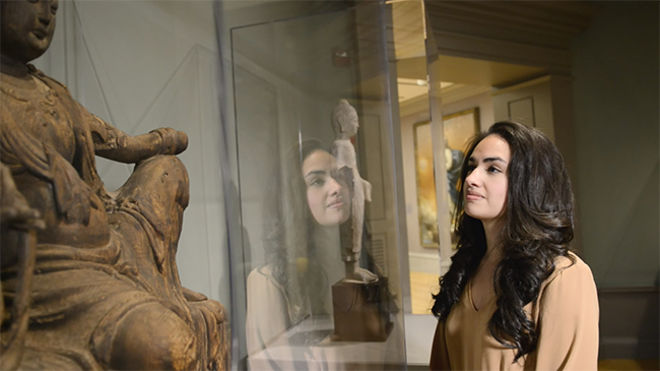Alyssa Velazquez (MA 2017) is the curatorial assistant for decorative arts and design at the Carnegie Museum of Art, in Pittsburgh, PA.
What attracted you to Bard Graduate
Center’s program?
It was required, in my final year of undergraduate course
work as an anthropology and history double major, to take a professional
development class in preparation for the next stage in our careers. Assignments
ranged from drafting cover letters to mocking up CVs and researching graduate
schools. At some point in my internet trolling for masters programs, I clicked
on Bard Graduate Center’s webpage, and as they say, that was it; it was love at
first click. I became enamored with the program’s ethos, and the more I clicked
around on the website’s list of class offerings, academic publications, and the
gallery’s exhibition schedule, the more I knew this was going to be my
graduate program. I distinctly remember seeing a course schedule from the
following year that included swimming pools, the history of collecting, and a
survey on magic. For me, a student from two fairly traditional academic
programs, this beautiful medley of material and design felt not only
interdisciplinary, it felt organic. It felt very human; it felt fun.
What was your focus of study here, how
did you find yourself involved with it?
Performativity is inherent in objects, and it is this
theatricality, as it relates to the interpretation and representation of the
decorative arts, that were cornerstones of my academic interests and practice
at BGC. As such, I gravitated to classes and offerings that went beyond the
institution’s four walls—seminars that looked at galleries, museums, and
collections as classrooms. One such course was “Curatorial Practice as
Experiment: A Chipstone Foundation-Bard Graduate Center Collaboration,” taught
by associate professor Catherine Whalen and Chipstone’s curator/ head
researcher Sarah Anne Carter. In addition to lectures and workshops with
leading movers and shakers in the field of art and design, the entire class was
invited for a weekend-long immersion in object study sessions at the Milwaukee
Art Museum and Chipstone Foundation. All of which culminated in a student
co-curated exhibition, Introspective:
Contemplations on Curating. To compliment this small exhibition installed
in the Object Lab, fellow second-year MA student Maggie Frick and I
developed an online platform for the show. This blog, served as a secondary
space for us to engage with BGC’s community on fundamental questions about
curatorial practice, with an ongoing events page, Instagram feed, inspiration
board, and topical research posts.
At that same time, I was involved in that year’s Focus
Project: “Ex Voto: Agents of Faith,” that utilized students’ research in the
development of the exhibition Agents of
Faith: Votive Objects in Time and Place, on view at Bard Graduate Center
from September 14, 2018 to January 6,
2019. While the source material for these two exhibitions couldn’t be more dissimilar,
both projects explored the display and interpretation of object-based research.
The creativity necessary to tell stories for objects that can’t speak for
themselves remains an ever-changing topic of conversation that begs the
question: “How do I make my work accessible, informative, and addictive? How can
I make someone never look at a chair the same way again?”
Describe your position at the Carnegie
Museum of Art and how you came to it. What sort of projects are you
working on?
I currently work as the curatorial assistant for decorative
arts and design at Carnegie Museum of Art in Pittsburgh. The department,
spearheaded by Rachel Delphia, the Alan G. and Jane A. Lehman Curator of
Decorative Arts and Design, is preparing for Extraordinary Ordinary Things, the forthcoming reinstallation of
the Ailsa Mellon Bruce Decorative Arts and Design galleries in summer 2021.
Pittsburgh has a reputation of being well-versed with “good design” from the
Kaufmann’s relationship to the Good Design exhibition series at MoMA to the
early pioneers at Carnegie Institute of Technology, and we are looking forward
to celebrating those local pioneers. Shifting from a history of style, this project reimagines the galleries to focus on makers and users
both living and historic. In keeping with the redesign, I am also curating the
exhibition Locally Sourced: Contemporary
Pittsburgh Products, which will highlight new work by some of the region’s
most talented makers of functional goods and furnishings.
In a city teeming with design firms and companies,
industrial design programs, and the Carnegie, I feel that Pittsburgh is a
makers’ mecca, and as someone who has made a career in the decorative arts and
design, I feel there’s no better place for me to be personally or
professionally than “the Burgh.”
How has your experience at Bard Graduate
Center helped you in your career?
So much of museum work is
ephemeral, so it is often what you do outside of label writing that leaves the
greatest impact on visitors. During my time at BGC, I worked in visitors’
services, education, and special events at the gallery. These various spheres
of museum work influenced the way I approach a project. When developing an
exhibition, I’m not only thinking curatorially, I’m thinking programmatically—symposiums,
workshops, partnerships, and online platforms. I want my work to be an
experience, and the BGC provided me means of reinterpreting the decorative arts
and design through imaginative forms of audience engagement outside of the
label box.
Photo by Drew Baron.












